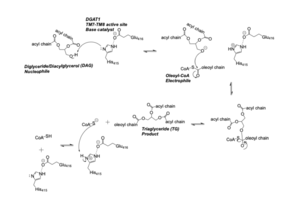Introduction
Diacylglycerol acyltransferase (DGAT) is a membrane protein that synthesizes triacylglycerides from its two substrates diacylglycerol (DAG) and fatty acyl-CoA for dietary fat absorption and fat storage. DGAT can be found expressed in the small intestine’s epithelial cells, in the liver where it synthesizes fat for storage, and in the female mammary glands where it produces fat for milk [1]. DGAT is a member of the membrane-bound O- acyltransferases (MBOAT) family [2]. All of the enzymes within this family are transmembrane enzymes that acylate lipids or proteins. Additionally, MBOAT enzymes have a conserved MBOAT core, a channel-like region that acts as the enzyme’s active site. Another feature of note within this MBOAT core is the conserved catalytic Histidine.
DGAT is a dimer that has two identical subunits. Each of the individual subunits contains an MBOAT core that acts as its active site. Each subunit also contains nine transmembrane alpha-helices (TM), 2 intracellular loops (IL), and one ER luminal loop (EL). TM2-9, IL1, and IL2 form the structure of the MBOAT core active site.
Function
DGAT synthesizes triacylglycerides from diacylglycerol (DAG) and fatty acyl-CoA. The catalytic mechanism for triacylglyceride synthesis by DGAT is shown in Figure 1.
Structure
Dimer Interface
Active Site
DAG Binding
Acyl-CoA Binding
Disease
Relevance
[2]
[1]

